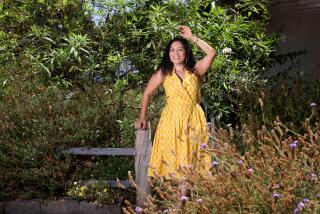GARDENS : Miniaturization : Japanese landscapes and bonsai plants are an attractive alternative to the usual ground covers and ornamental plants.
- Share via
This spring homeowners might want to borrow elements from Japanese-style gardens instead of planting the usual ground cover and ornamentals. A little planning and imagination could yield a lovely low-maintenance garden that is also drought-resistant. And it is not necessary to spend a fortune or to use authentic Japanese plants to achieve the desired effect.
For instance, ground cover ice plant or ivy could be replaced with juniper, a low, horizontally growing evergreen. Requiring little water, this hardy plant can be trimmed to resemble a small tree or allowed to attain a wind-swept appearance often associated with Asian gardens.
Another option is the substitution of sand, smooth pebbles, or gravel for vegetal ground cover. Lovely landscapes can be composed with as few as three elements.
Consider the traditional Japanese “turtle island” consisting of a rippling “sea” of raked gravel, one tree, some large stones and clumps of Irish moss for color and textural contrast.
For people who prefer more color, “there are a lot of flowering and fruiting trees including flowering pear, plum and quince that can be used in the context of a Japanese garden,” said Jim Downer, an environmental horticultural adviser with U.C. cooperative extension in Ventura. He says the climate in this area is not cold enough to promote good flowering of authentic Japanese flowering cherry trees.
“But many plants can be made to look like they belong in an Oriental garden simply by the maintenance and pruning procedures we use,” Downer said. He cites the Australian tea tree--with its twisted, gnarled trunk--as an example.
The key to a successful garden of any type, said Downer, is proper selection, placement and maintenance of the chosen elements.
For people who have minute gardens or who live in condominiums, there are other ways besides creating raked gravel seascapes, to bring nature to a small plot or patio.
Brad Hart, owner of “Bonsai from the Hart,” in Ventura, said, “Bonsai is the bringing of the outdoors and forest of distant places into the home by miniaturizing it. A bonsai means any plant that has been dwarfed, shaped, and put into a shallow container by pruning the roots.”
“A lot of people think a bonsai is only a tree,” Hart said. “But some of the most widely used plants here and in Japan for making bonsai are shrubs like cotoneaster and azalea.”
Hart particularly favors azaleas because, he said, they can be pruned to produce dense foliage and they have a nice weathered looking trunk. They grow rapidly and have the bonus of annual flowering. The variety of azalea most commonly used for bonsai is the satsuki, which produces a variety of solid-colored flowers as well as some with striped petals.
You can start a bonsai from a cutting about three inches long by dipping the roots in growth hormone before planting. Using copper-coated wire to prevent rusting, the tree is shaped to grow into the cascading, windswept or upright styles favored in Japanese gardens.
Hart said that a 3- to 4-year-old bonsai may cost from $20 to $30. You can make one tree the focus of your garden, or have a “forest” or grouping of several trees in the same container.
Most bonsai are outdoor plants and do best on a protected patio with three to four hours of morning sun a day, said Hart. They need fresh air and humidity but should be brought indoors in extreme heat or if frost is a possibility.
“Bonsai are not tricky to own,” Hart said. “With a little patience they will turn into something special. And as long as they receive the care required, they’ll outlive their master.”
BONSAI TIPS
* Brad Hart’s bonsai trees are sold at Crafter’s Showcase, 573 E. Main St., in Ventura and at the farmers’ markets in Ventura and Santa Barbara counties.
* Bonsai trees are also sold at Fuji Bonsai Nursery, 13170 GlenoaksBlvd., Sylmar (818) 367-5372.
* This is the season to plant azaleas and camellias, which are on sale at most nurseries and garden centers.
* For more information about planning a Japanese garden, see the Ortho paperback book, “Creating Japanese Gardens,” by Alvin Horton.
* To locate a class on bonsai for hobbyists, contact a community college or adult education program in your area.






